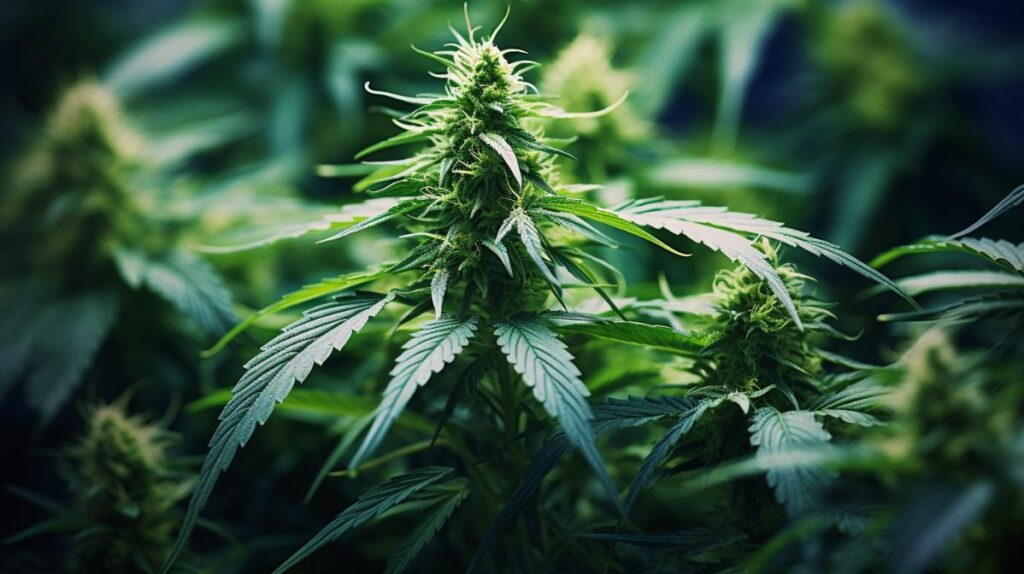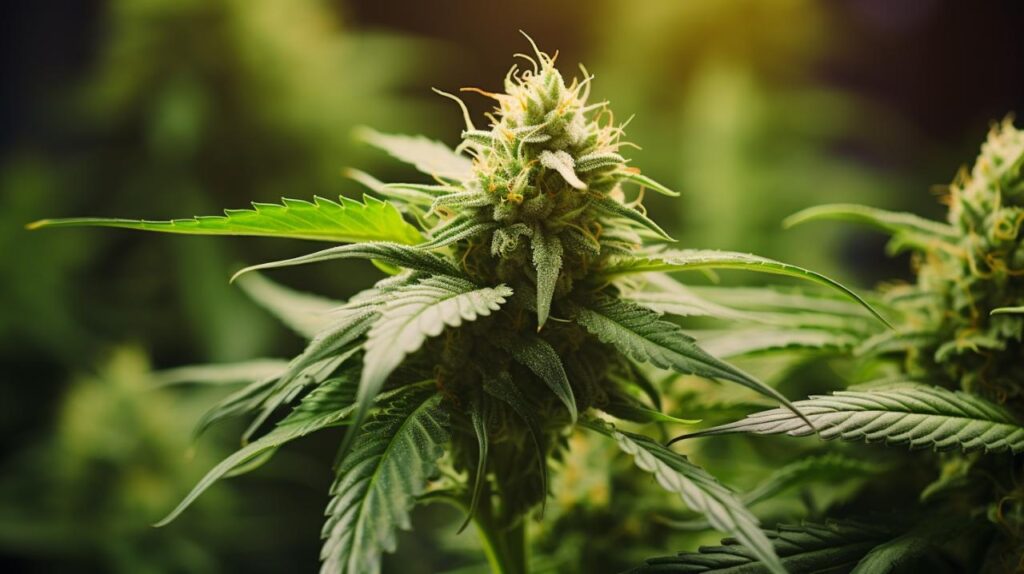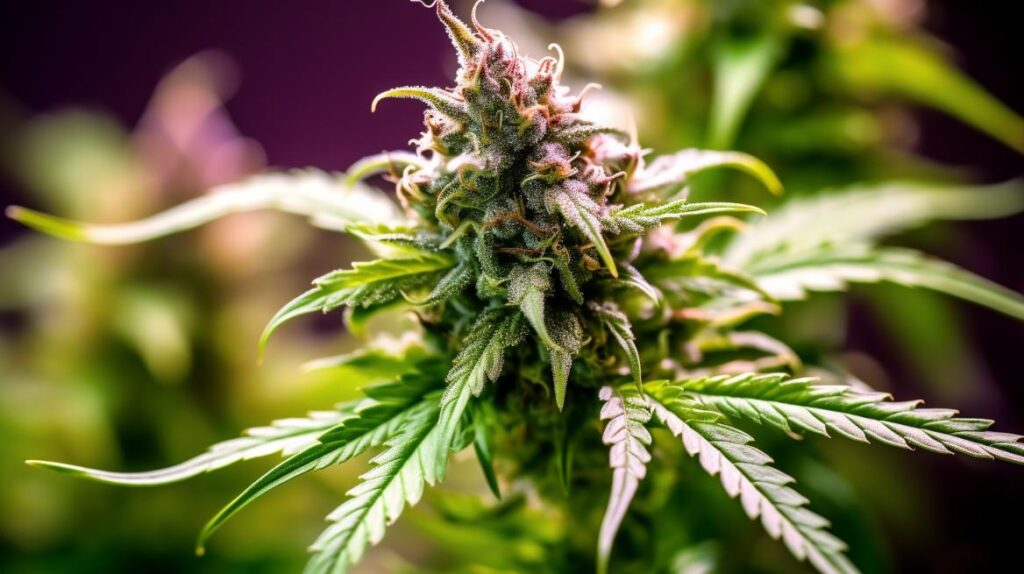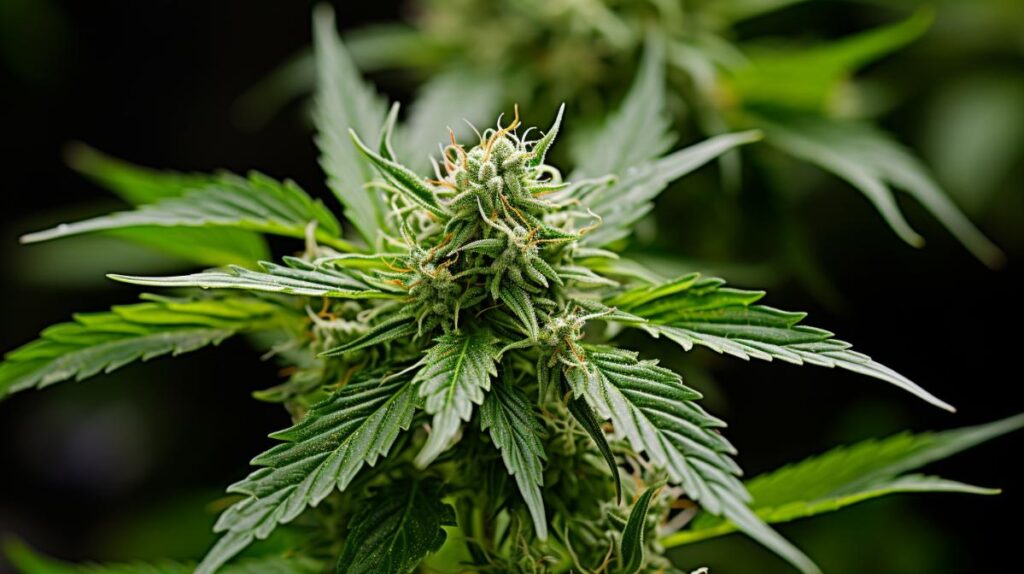Watermelon (aka Watermelon Kush, Watermelon OG)

The Watermelon Weed Strain, with its alluring aroma reminiscent of fresh summer fruit, represents a nuanced chapter in the annals of cannabis cultivation. This indica-dominant hybrid, characterized by its sweet taste and potent effects, has garnered attention for both its recreational and therapeutic applications.
Its genetic lineage, which contributes to the strain’s sedative properties, raises questions about its suitability for various consumers, particularly in relation to its anxiolytic and analgesic potential. While the initial experience may seem deceptively benign, due to the strain’s enticing flavor, the psychotropic impact attributed to its relatively high tetrahydrocannabinol (THC) content is worthy of a more comprehensive exploration.
As we examine the Watermelon Weed Strain’s multifaceted profile, one must consider the balance between its soothing qualities and the possible adverse reactions, thus underscoring the importance of informed usage and the implications for cultivators and consumers alike.
Genetic Lineage
Delving into the enigmatic roots of the Watermelon weed strain, we encounter an indica-dominant hybrid with a genetic lineage shrouded in mystery, yet defined by its capacity to induce a stoning and euphoric high complemented by a distinct fruity terpene profile. This elusive genetic background, created through the marriage of two unidentified parents, has given rise to a strain celebrated for its deeply relaxing and sedative effects that aficionados of indica strains have come to cherish.
The genetic history of the Watermelon strain is not just a tale of obscurity, but also one of mastery over the cultivation process. Advanced growing techniques such as Low Stress Training (LST), topping, and mainlining are often employed to enhance the yield of this strain, illustrating the versatility and resilience inherent in its genetic makeup. The presence of fruity terpenes, which impart the characteristic watermelon flavor, is a testament to the intricate genetic tapestry that defines this strain.
As connoisseurs of cannabis explore the Watermelon strain, they are not only met with a delightful sensory experience but also a profound appreciation for the complexity and subtleties encoded in its genetic background. Despite its unknown parentage, the Watermelon strain stands as a paragon of the rich botanical and biochemical diversity found in cannabis genetics.
THC/CBD Content
Expanding upon the Watermelon strain’s enigmatic allure, its THC and CBD content play pivotal roles in both the intensity and nature of the effects experienced by users. Often sought after for its relaxing yet euphoric high, the Watermelon strain boasts a substantial THC content, typically ranging between 11% and 22%. This variance in THC levels allows for a flexibility of use, catering to both novice consumers who may prefer a milder experience and seasoned users seeking a more potent effect.
The CBD content in Watermelon is considerably lower, often falling below 1%, which is not uncommon for strains that emphasize THC. The modest presence of CBD does not detract from Watermelon’s therapeutic qualities but does spotlight THC’s dominant role in shaping the strain’s psychoactive profile. Users can anticipate a calming body high that underscores THC’s influence, with the strain’s analgesic and anxiolytic properties being attributed to its synergistic cannabinoid and terpene profile.
Understanding the THC and CBD content is crucial for consumers aiming to align their usage with personal wellness goals. As with any cannabis strain, it is advisable to start with a lower dose to gauge individual tolerance, particularly with Watermelon’s potentially high THC content.
Terpene Profile
The Watermelon strain’s aromatic signature is defined by a rich terpene profile that not only imparts its characteristic watermelon scent and taste but also plays a significant role in enhancing the therapeutic and psychoactive effects users experience. This curated blend of terpenes is not only a delight to the olfactory senses but also intermingles with the taste buds to deliver a delectable and memorable experience.
-
Fruity Terpenes: The presence of fruity terpenes is pivotal in bestowing the Watermelon strain with its distinctive flavor that mirrors the refreshing qualities of its namesake fruit, enticing the palate and setting the stage for the unique effects to follow.
-
Entourage Effect: These terpenes synergize with cannabinoids to amplify the strain’s potency through the entourage effect, thus optimizing the impact on both mind and body.
-
Limonene: With limonene in the mix, users may feel a mood elevation and stress relief, complemented by a subtle citrus aroma that brightens the overall sensory experience.
-
Myrcene and Caryophyllene: Myrcene contributes to the strain’s calming influence, while caryophyllene offers potential therapeutic benefits, such as anti-inflammatory and analgesic effects, enhancing the strain’s appeal to those seeking relief.
This symphony of terpenes ensures that with each use, the Watermelon strain provides a multifaceted experience, engaging the senses and offering various potential wellness benefits.
Effects
Building on the understanding of the Watermelon strain’s terpene profile, it is critical to examine the effects these aromatic compounds have on users, particularly in terms of relaxation and therapeutic relief.
The Watermelon strain’s deeply relaxing qualities shine through as users often experience a calming effect that eases the body into a state of tranquility. This soothing sensation is conducive to sleep, making the strain a potential ally for those grappling with insomnia.
The strain’s ability to stimulate hunger is another notable effect, which may be beneficial for individuals seeking appetite enhancement, often critical for patients undergoing certain medical treatments. Moreover, the therapeutic benefits extend to psychological well-being, with users reporting significant relief from anxiety, stress, and chronic pain, which underscores the strain’s versatility in addressing both physical and mental health concerns.
However, while the strain’s sweet and tropical flavors, enriched with a grape-like essence, offer a palatable experience, users should be aware of possible side effects. Headaches, dizziness, and dry eyes are among the minor discomforts that could accompany its use. It is essential for users to consider these potential drawbacks while appreciating the strain’s remedial properties.
Medical Uses
Harnessing its unique blend of terpenes and cannabinoids, the Watermelon strain has been leveraged in medical settings to alleviate a spectrum of ailments, from chronic pain to anxiety disorders. This cannabis variety is particularly noted for its physically relaxing properties, which can aid patients seeking relief from tension and discomfort without the harsh side effects of traditional pharmaceuticals.
The medical applications of the Watermelon strain are varied and can be outlined as follows:
-
Pain Management: Its potent analgesic properties are effective in dulling neuropathic and inflammatory pain, offering a natural alternative to opioid-based medications.
-
Anxiety and Stress Relief: The strain’s anxiolytic effects help in reducing symptoms of anxiety and stress, promoting a sense of calm and well-being.
-
Sleep Disorders: The sedative qualities inherent in the Watermelon strain make it a suitable option for individuals grappling with insomnia or other sleep-related issues.
-
Muscle Spasms: Patients dealing with muscle spasms and cramps may find the physically relaxing effects of Watermelon beneficial in easing their discomfort.
Flavor and Aroma
While the Watermelon strain is celebrated for its therapeutic benefits, its organoleptic properties are equally impressive, featuring a distinctive flavor profile that endears it to connoisseurs and casual users alike. As one delves into the sensory qualities of this strain, the initial encounter is with its rich, fruity aroma that immediately conjures images of lush tropical groves. This aromatic bouquet is predominantly marked by the sweetness of ripe watermelon, a scent that is both inviting and comforting.
Upon consumption, the Watermelon strain’s flavor fully lives up to its aromatic promise. Users are treated to a velvety, sweet taste that flawlessly mirrors the essence of the fruit it’s named after, with an added depth provided by subtle grape undertones. These flavors are most pronounced and enjoyable when the strain is vaped at lower temperatures, a method that allows for the terpenes responsible for these flavors to be fully appreciated without being overshadowed by the heat.
The interplay between the Watermelon strain’s flavor and aroma creates a comprehensive sensory experience that is not only pleasant but also refreshing. This experience is further enhanced by its significant THC content of 22%, which ensures that the enjoyment of its delightful flavor and aroma is accompanied by a profoundly relaxing and stoning high.
Appearance
The Watermelon marijuana strain boasts a visually striking appearance, characterized by its fluffy pale green nugs tinged with vivid pink undertones, bright orange hairs, and a generous coating of frosty white crystal trichomes. It stands out in a garden or dispensary with its unique color palette and structure that captures the attention of cannabis enthusiasts and cultivators alike.
The distinctive features of Watermelon’s appearance include:
-
Large, Chunky Flowers: These voluminous blooms have a somewhat loose and airy structure that allows the unique coloration to stand out.
-
Bright Yellowish-Green Leaves: The soft, fluffy leaves provide a contrast against the deeper hues and emphasize the orange hairs and trichome coverage.
-
Curly Orange Hairs (Pistils): These serve not only a reproductive function but also add to the visual allure with their fiery coloration weaving through the frosty green backdrop.
-
Thick Trichome Blanket: A dense layer of trichomes gives the Watermelon strain its sparkling, sugary finish, hinting at the potency within.
Analyzing the Watermelon strain’s appearance reveals an alluring combination of color and texture, indicative of careful breeding for both aesthetics and quality. It’s a treat for the eyes as much as it promises to be for the palate, with the orange hairs and trichomes forecasting the flavorful experience to come.
Grow Information
Moving beyond the striking visual appeal of the Watermelon marijuana strain, cultivators will find its growth patterns equally distinctive, with an indica dominance that suits even compact growing spaces. This strain is not only a feast for the eyes but also a high yield producer, particularly when grown indoors where its manageable stature can be maximized through various cultivation techniques.
The Watermelon strain is responsive to Low Stress Training (LST), topping, and mainlining, all of which can enhance the yield potentially reaching up to 17.6 oz/m². For those with more space, growing Watermelon outdoors is also rewarding, as the plants can stretch taller in the fresh air, suitable for regions with shorter summers due to its relatively quick flowering time.
Here’s a snapshot of Watermelon’s grow information:
| Growth Trait | Indoor | Outdoor |
|---|---|---|
| Yield | Up to 17.6 oz/m² | 4.9-6.6 feet tall plants |
| Height | Compact, suitable for LST | Taller, suited for short summers |
| Variety | Watermelon Automatic | Traditional Watermelon strain |
| THC Content | 20% (Auto) | 22% |
| Life Cycle | 6-7 weeks (Auto) | Standard flowering period |
For aficionados who look forward to a quiet, relaxing setting to enjoy their harvest, vaping Watermelon buds at lower temperatures can enhance the strain’s delectable watermelon flavor profile and its relaxing, stoning effects.
Adverse Effects
Understanding the potential adverse effects of the Watermelon marijuana strain is crucial for users to enjoy its benefits responsibly and mitigate any negative experiences. While the strain is generally known for its pleasant effects, it’s important to acknowledge that, like all cannabis strains, Watermelon can produce unwanted reactions in some individuals. These adverse effects may vary in intensity and frequency but being informed can help users make better consumption choices.
Here are some adverse effects that users should be aware of:
-
Headaches: Although this is not a common side effect for all users, some individuals may be more prone to experiencing headaches after using the Watermelon strain.
-
Dizziness: This strain can cause a temporary sensation of lightheadedness or dizziness, which usually subsides after a short period.
-
Dry Eyes: A frequent adverse effect of many cannabis strains, including Watermelon, is the experience of dry eyes, which can be alleviated with the use of eye drops.
-
Dehydration: Watermelon strain use may lead to dehydration. It is advisable to consume plenty of water before, during, and after use to prevent this issue.
Users should also consider that the sedative properties of this strain may cause drowsiness or sleepiness, making it unsafe to operate heavy machinery or drive vehicles after consumption.
Comparisons with Similar Strains
Several cannabis strains bear a resemblance to the Watermelon variety in terms of their effects, flavors, and cultivation characteristics, providing a spectrum of options for connoisseurs seeking similar experiences.
The Watermelon strain, much like the cherished Watermelon Kush, delivers a deeply relaxing and potentially sleepy high, which can be compared to the well-known sedative effects of Granddaddy Purple and Northern Lights. These strains share a penchant for tranquility, making them favorites among users looking to wind down.
When exploring the flavor profiles, Watermelon’s sweet and tropical essence places it alongside strains like Pineapple Express and Mango Kush. These varieties are celebrated for their fruity and refreshing taste that evokes a sense of summer indulgence. Additionally, the therapeutic benefits of Watermelon, particularly its ability to alleviate stress, anxiety, and pain, mirror the properties found in OG Kush and Blue Dream, both of which are also hailed for their calming and analgesic effects.
Cultivators appreciate Watermelon’s medium stature and its responsiveness to low-stress training (LST) techniques. This makes it similar to White Widow and AK-47, which are also known for their adaptability and suitability for growers with spatial constraints. For those interested in autoflowering varieties, Watermelon Automatic stands parallel to Northern Lights Auto and Blueberry Autoflower, offering ease of cultivation and a swifter path to harvest.
Research and Studies
Building on the sensory and cultivation parallels drawn with other strains, scientific inquiry into the Watermelon weed strain offers insights into its unique composition and the implications for its therapeutic potential. The research and studies conducted on this particular strain highlight several aspects that define its effects and user experience.
Research and Studies Key Points:
-
The indica-dominant hybrid nature of the Watermelon strain may offer therapeutic benefits, particularly in treating conditions such as anxiety, stress, and sleep disorders due to its sedative and relaxing effects.
-
Its terpene profile is responsible for the Watermelon strain’s distinctive fruity scent and taste, which not only enriches the user experience but also possibly influences the strain’s therapeutic qualities.
-
With a significant THC level of around 22%, the Watermelon strain is suggested to provide users with a calming and potent high, aligning with anecdotal reports of its strong sedative effects.
-
The research points to Watermelon Automatic as an appealing option for its rapid growth cycle and robust THC potency, offering a practical solution for those desiring a fast-maturing, efficacious cannabis strain.
Ongoing research is critical in substantiating the anecdotal claims and understanding the full spectrum of Watermelon strain’s medical applications, including its role in pain relief, appetite stimulation, and sleep improvement.
History and Origin
Shrouded in enigma, the Watermelon weed strain emerges as an indica-dominant hybrid whose origins are veiled by the secrecy of its unknown parentage, creating a tapestry of speculation and allure among cannabis connoisseurs. Despite its concealed lineage, the strain has captivated users with its distinctive watermelon aroma and enduring sedative effects. The cryptic background suggests that its progenitors may lie within the Berry family, yet the exact combination remains an alluring puzzle.
The Watermelon strain’s history is as rich in mystery as its effects are in depth. Its soothing and calming influence is particularly noted for alleviating symptoms associated with anxiety, stress, depression, and insomnia. The strain’s profile is a complex bouquet of fresh sweet watermelon and sugary fruit flavors, underscored by a hint of skunkiness and tropical sweetness that tantalizes the senses. This unique sensory experience has cemented Watermelon’s status within the cannabis community.
The strain’s euphoric and appetite-stimulating effects have garnered it favor among those who prefer their indica to be accompanied by a fruity sweet palate. As such, the history of the Watermelon weed strain, though obscured by its unknown parents, is celebrated for its delightful contribution to the world of cannabis strains.
Frequently Asked Questions
Is Watermelon a Sativa or Indica Strain?
The inquiry pertains to strain genetics, specifically the classification of a varietal as either sativa or indica. The Watermelon strain is an indica-dominant hybrid, celebrated for its sedative effects and fruity flavor profile.
Is Watermelon Burst a Sativa or Indica?
Watermelon Burst is predominantly an indica strain, with a flavor profile that is notably characterized by a pronounced watermelon taste, appealing to those seeking a fruity and sweet experience with their cannabis selection.
Is Watermelon Punch a Sativa or Indica?
The genetic lineage of Watermelon Punch suggests it is an indica-dominant hybrid. This categorization aligns with its purported effects that emphasize relaxation, commonly associated with indica strains in the cannabis family.
Is Watermelon OG Strong?
Watermelon OG exhibits a broad genetic variation that translates into a potent THC concentration, approximately 22%, resulting in robust sedative effects, which might be beneficial for those seeking relief from stress or insomnia.







Responses